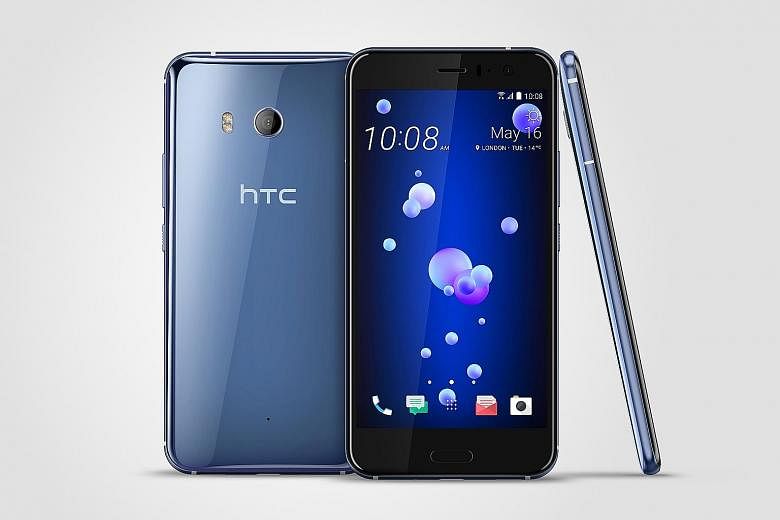Phone manufacturers have been quite restrained with their flagship smartphones this year, with nothing too outlandishly gimmicky released so far.
But HTC has bucked the trend with its premium HTC U11, which features a brand-new pressure sensor on the bottom half that lets you activate certain actions by squeezing the phone.
Thankfully, it's an option that doesn't affect the look, feel and performance of the U11, which is shaping up to be a much-needed premium flagship for the Taiwanese phonemaker.
The U11's design is similar to that of its earlier U Ultra mid-range phone, featuring a glass-and-metal build that's all the current rage.
It is a very polished phone in more ways than one, with a nice, premium hand-feel and a glass back that's a joy to feel and look at - but this also makes it a fingerprint magnet that leaves smudges with a single touch.
The bright colours that the U11 comes in do make the various models stand out, but HTC isn't content with making it the phone's standout feature. Instead, it has added what it calls an Edge Sense feature, with which a squeeze of the smartphone lets users customise it to perform certain actions.
A single, short squeeze can be customised to launch the camera, for example, and a longer squeeze to fire up Google Assistant.

There are 10 squeeze force levels to match how much force is needed, but why anyone would want to go above three or four is beyond me.
It actually does take some effort to squeeze the phone - it's not so easily triggered that a gentle nudge sets it off - and so the higher the force levels, the harder you have to squeeze the phone.
Because it works through pressure, not capacitive touch, you can still slap on a case on the U11 and make use of the squeeze feature.
Is it useful? Yes, in some cases, such as maybe surreptitiously firing up the camera and snapping a few shots without actually using a finger to poke the shutter button. But is it also quite gimmicky? Yes.
-
TECH SPECS
PRICE: $998
PROCESSOR: Qualcomm Snapdragon 835 (Quad-core 2.45 GHz and Quad-core 1.9 GHz)
DISPLAY: 5.5-inch, Quad HD, 2,560 x 1,440 pixels, 534 ppi pixel density
OPERATING SYSTEM: HTC Sense (Android 7.1 Nougat)
CAMERA: 12MP, f/1.7 (rear); 16MP, f/2.0 (front)
MEMORY: 128GB (microSD, expandable up to 2TB), 6GB RAM
BATTERY: Non-removable 3,000mAh
RATING
FEATURES: 5/5
DESIGN: 5/5
PERFORMANCE: 5/5
BATTERY LIFE: 4/5
VALUE FOR MONEY: 4/5
OVERALL: 5/5
It's as though the Taiwanese phonemaker felt obliged to squeeze in a new feature that's never been seen before into the U11 at all costs, and this was what they came up with.
Thankfully, it's not an intrusive gimmick, so feel free to not use it if it doesn't appeal to you.
As a whole package, the U11 performs superbly, from its blazing-fast Snapdragon 835 - the latest in the market - to its 6GB of RAM. Apps open near-instantaneously and the phone doesn't stutter even when starting multiple apps, which makes it good for heavy multitasking use.
However, battery life is not fantastic. It will last a full day of moderate use, but doesn't leave much reserve that will give you peace of mind if you somehow find yourself out of reach of a charger during the evening.
There is little to complain about the U11's camera as outdoor pictures are incredibly sharp and vivid, while low-light photos are sufficiently detailed and not so grainy, thanks to the phone's post-processing software.
There's good colour reproduction across the board that doesn't overly exaggerate certain colours and remains quite true to life. However, there is a noticeable shutter lag time, which is strange given the U11's specs. It can still take quick snaps, but lags behind other flagships in this respect.
HTC has done away with the 3.5mm headphone jack on the U11, much like on its U Ultra phone, which leaves only a USB-C port for your audio needs.
You'll have to listen to audio either wirelessly through Bluetooth or use a pair of USB-C earphones, or cough up an additional $16 for a 3.5mm headphone jack adapter.
HTC claims this decision was to deliver a better audio experience with the U11's bundled in-ear earphones that can digitally map out the user's ears and calibrate an appropriate sound profile, although most consumers would likely want to use headphones they like and bought for their own use.
•Verdict: The HTC's U11 squeeze feature may be little more than a gimmick to differentiate it from the crowd, but it doesn't detract from the rest of the package. It's a genuinely solid flagship for the Taiwanese firm looking to make a comeback in the smartphone market, but is held back by the lack of essential features such as a headphone jack.


